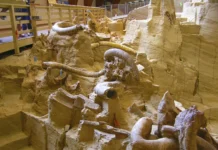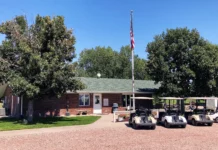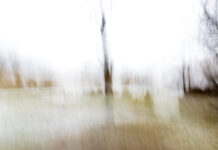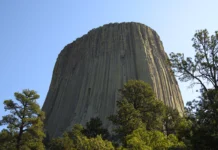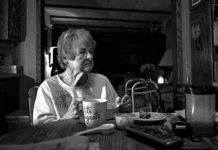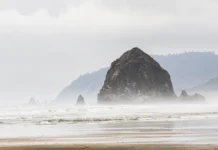| TRAVEL |
Story & Photography by: Hawk Buckman
On any given summer evening, when the sun drops low and the heat finally starts to fade, you’ll spot them: Jeeps with the doors off, the roof stashed in a garage somewhere, and a couple of friends rolling slowly through town or down some country dirt road. The music drifts, the air rushes, and the world feels lighter for a while. We call it jeep-therapy.
We’ve got a friend going through a rough patch with family health struggles. Between the medical bills, treatments, and the weight of running her own household, the stress has been relentless for her and her family. Every couple of days she’ll call and ask if she can get us to take a ride outside of town—hit some gravel—for a ride, a beer, or just some quiet time in the jump seat while we roll down a red dirt road with the doors and top off. Over time, we started calling it jeep-therapy. Sure, the same feeling can come from motorcycles, convertibles, or even a bike ride, but it’s in the Jeep—duck duck Jeep— community where this kind of open-air escape truly shines.
It’s not a brand slogan or a marketing campaign. It’s a tradition that’s spread word-of-mouth among Jeep owners who’ve discovered that sometimes, the best remedy for a long week isn’t a couch or a prescription—it’s an open road, a horizon, and a vehicle designed to strip away barriers between you and the outside world.
Jeep-therapy isn’t about speed or off-road adrenaline. It isn’t about horsepower or mud-slinging bravado. It’s not about “driving” so much as it’s about letting go. A ride like this is equal parts escape, reset, and ritual—and for a lot of us, it works better than sitting in an office or staring at a phone. It’s about the ritual.
There’s a rhythm to jeep-therapy. At first, the chatter is light—work gripes, family updates, the usual. But by the time we’ve left town and rolled into open country, something shifts. Shoulders drop. Breathing slows. That looming problem at work? It doesn’t feel as sharp anymore.
Part of it is the air—wide open, constant, wrapping around you like a fresh start. Psychologists have a term for this: exposure therapy to nature. Studies show that even short stretches in green or blue spaces—fields, rivers, lakes—can lower stress hormones, ease anxiety, and sharpen focus. Out here, you don’t have to look for nature. You’re immersed in it.
Researchers call it “dose of nature”—even 10–20 minutes makes a measurable difference in mood. Out here, you’re not watching a clock. You’re just letting the miles work their magic.
The beauty of jeep-therapy is that it doesn’t require planning. That quick 20-minute loop through farm roads after a long day can clear the fog. A Saturday spent chasing a river road or heading toward a state park can feel like a mini-vacation.
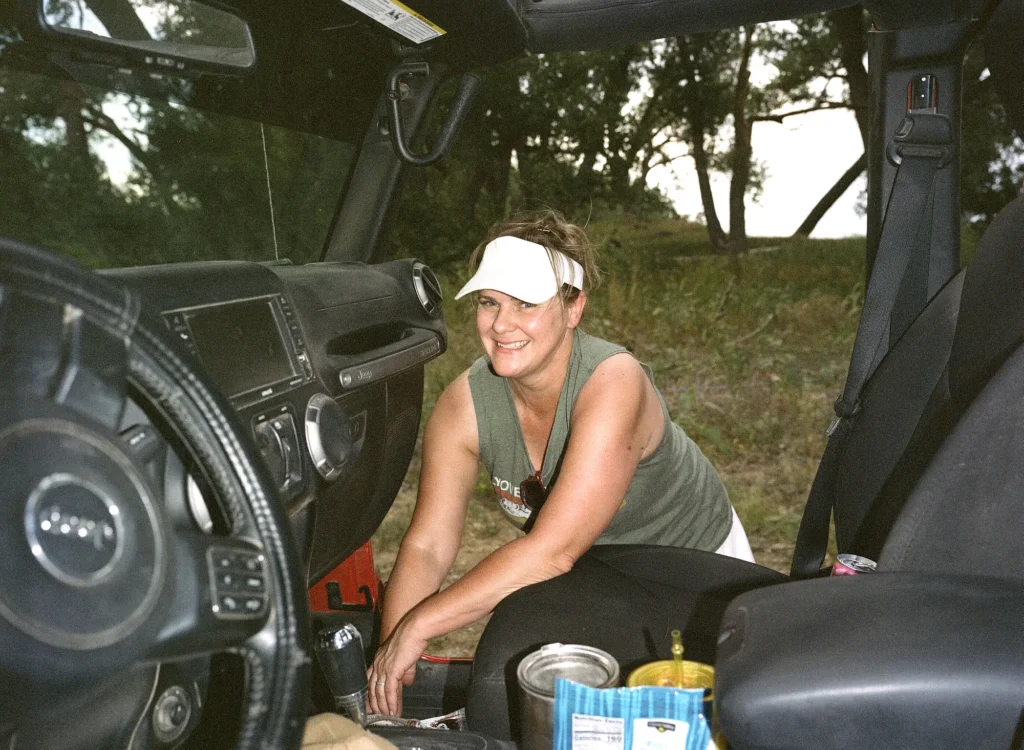
| WHY IT WORKS
- Wind as Release. Riders often describe the sensation of wind whipping past as cleansing—like the day’s stress is physically carried away. That feeling, nicknamed “wind therapy” in motorcycle and open-air driving circles, has been noted to lower tension and boost alertness.
- Nature as Medicine. Research consistently shows that time spent in green or blue spaces—fields, forests, rivers, lakes—lowers cortisol, reduces anxiety, and improves mood. Jeep-therapy puts you directly into those landscapes, without the walls or glass of a traditional vehicle muting the experience.
- Awe as Perspective. Awe-inspiring views—whether a prairie sunset, mountain ridge, or starlit sky—have been shown to reduce rumination and increase positive emotions. Jeep rides often deliver those moments unexpectedly, tucked around the next bend.
- Music as Mood Guide. The soundtrack matters. Calm tracks can slow the pace and soothe nerves; upbeat anthems can recharge energy. Psychologists studying music and driving note that tempo and volume shape both mood and behavior, making the playlist part of the therapy itself.
- Connection Without Pressure. Jeep-therapy isn’t just about solo rides. Sitting side-by-side, facing the horizon, makes it easier to talk—or to stay silent together. That social connection, even without words, is one of the strongest buffers against stress.
| THERAPY ON FOUR TIRES
If you strip jeep-therapy down to its core, it’s simply a modern spin on something humans have always sought: a break in the routine, a breath of fresh air, and the perspective that comes from stepping out of life’s daily grind.
Some people fish, some hike, some take long runs. Jeep owners pull the top off and point the grille toward the horizon. The result is the same—clarity, calm, and a reminder that problems rarely feel as big when seen against the backdrop of an endless sky.
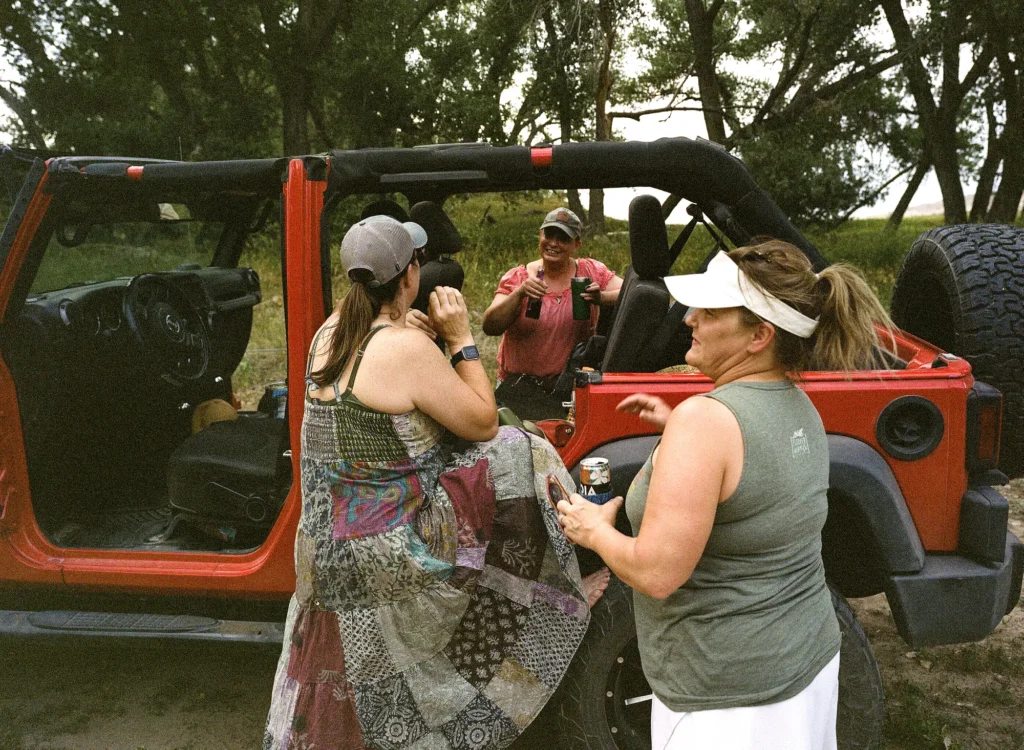
Jeep-therapy isn’t therapy in the clinical sense, but it’s therapeutic in the truest sense of the word. It clears the mind, restores perspective, and strengthens bonds between friends. It’s not about where you’re going, but about the space the ride creates.
At the end of the day, that’s the secret: no doors, no roof, and no urgency. Just a road, a breeze, and the freedom to breathe a little easier.
This is a short article based on a big list—and bigger brains—that the content was referenced from. The list was generated by ChatGPT, but the article itself is written by hand by Hawk Buckman.
We encourage you to take the time to care for yourself and relieve some of the stress in your life—whether by taking a walk, going for a ride, or talking things over with friends. Stepping away from the stress, even for a little while, can make a real difference. It will help prolong your life, strengthen your health, and give you the space to breathe a little easier.
| REFERENCES & MORE INFORMATION
- Spending at Least 120 Minutes a Week in Nature Is Associated with Good Health and Well-Being — Scientific Reports (2019)
- Urban Nature Experiences Reduce Stress in the City: A Longitudinal Field Study of a “Nature Pill” — Frontiers in Psychology (2019)
- Urban Green Spaces and Health: A Systematic Review and Meta-Analysis — Environmental Research (Twohig-Bennett & Jones, 2018)
- Green and Blue Spaces and Mental Health — WHO Europe Report (2021)
- Outdoor Blue Spaces, Human Health and Well-Being: A Systematic Review — Health & Place (Gascon et al., 2017)
- Mechanisms of Impact of Blue Spaces on Human Health: A Systematic Review and Meta-Analysis — International Journal of Environmental Research and Public Health (2021)
- Big Smile, Small Self: Awe Walks Promote Prosocial Positive Emotions in Older Adults — Emotion (2020)
- ‘Awe Walks’ Boost Emotional Well-Being — UCSF News (2020)
- Motorcycle Riding May Reduce Stress Biomarkers and Increase Alertness — UCLA Newsroom (2019; study released 2021)
- Music Therapy for Stress Reduction: Systematic Review and Meta-Analysis — Health Psychology Review (de Witte et al., 2020)
- Music Listening and Stress Recovery in Healthy Individuals — PLOS ONE (2022)
- Social Relationships and Mortality Risk: A Meta-Analytic Review — PLOS Medicine (Holt-Lunstad et al., 2010)
- Stress, Social Support, and the Buffering Hypothesis — Psychological Bulletin (Cohen & Wills, 1985)








